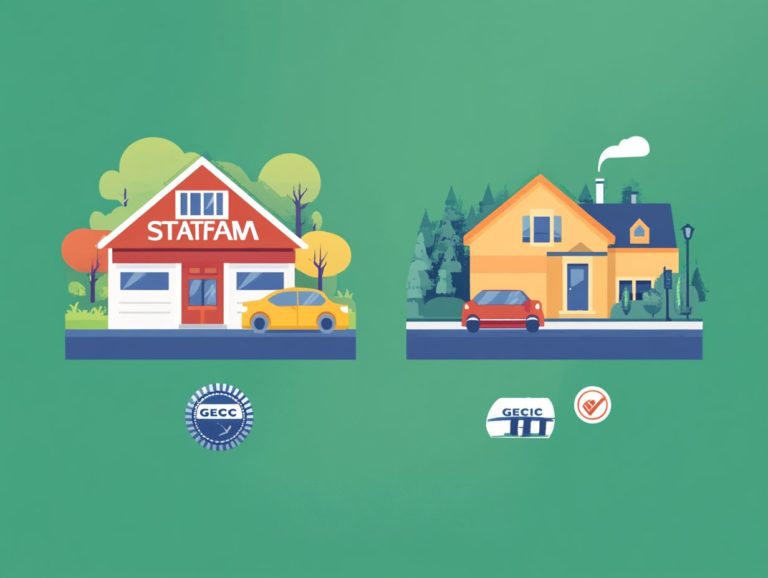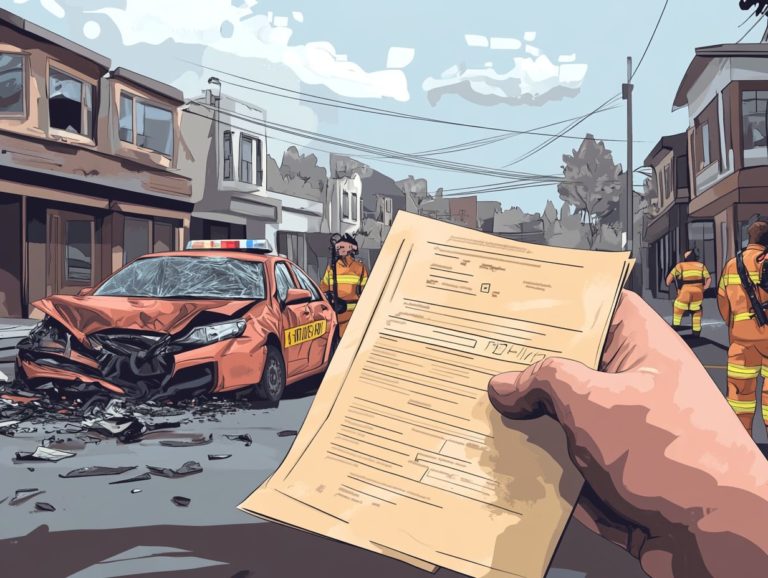What is Gap Insurance and Should You Compare It?
In today s fast-paced world, grasping the nuances of gap insurance is crucial for vehicle owners. This article will explain what gap insurance is and whether you need it.
We will compare gap insurance with other coverage types. By doing so, you can evaluate the benefits and drawbacks effectively.
By the end, you ll be ready to take charge of your coverage needs.
Contents
Key Takeaways:

- Gap insurance covers the “gap” between what your car is worth and what you owe on your loan in the event of a total loss.
- Assess your vehicle and current coverage to determine if gap insurance is necessary for you.
- When comparing gap insurance policies, consider factors like cost, coverage limits, and deductibles.
Understanding Gap Insurance
Gap insurance, or guaranteed auto protection, helps you avoid financial strain after a total loss. It covers the difference between what you owe on your loan and your car’s actual cash value.
Should you experience an accident that results in a total loss, gap insurance steps in to bridge the gap between the insurance payout and the outstanding loan or lease balance on your car. This coverage is especially vital considering how quickly vehicles depreciate.
Definition and Purpose
The essence of gap insurance lies in its power to shield you from financial losses stemming from negative equity. If your car’s value drops below what you owe on it, that s called negative equity. In that case, gap insurance can save you from financial stress.
This type of insurance serves as a vital safety net. It covers the gap between your auto loan and your car s actual cash value during an accident or theft.
In situations where traditional auto insurance only reimburses you for the market value of your vehicle, gap insurance lightens the load of any outstanding loan balances. This can prevent significant financial strain during what is already a challenging time.
Do You Need Gap Insurance?
Determining whether you require gap insurance involves a careful evaluation of your vehicle, your current car loan, and your potential financial exposure in the event of a total loss.
Are you financing a new car? If so, the risk of negative equity increases, making gap insurance a wise decision to protect against potential financial setbacks.
Assessing Your Vehicle and Coverage

Assessing your vehicle’s value is essential. It requires a careful evaluation of your auto financing situation, specifically looking at the vehicle’s worth and your outstanding loan balance.
To effectively gauge your vehicle’s worth, consider utilizing tools like Kelley Blue Book and the National Automobile Dealers Association (NADA). These resources can provide invaluable insights, allowing you to compare current market prices accurately.
These assessments are crucial for understanding how much protection you may need. They can influence your financing decisions, leading to more informed choices about loan terms and insurance options.
Comparing Gap Insurance to Other Types of Coverage
When assessing your auto insurance options, it’s crucial to understand how gap insurance compares to other coverage types like collision insurance and replacement value insurance.
Gap insurance is designed to cover the difference between your vehicle’s actual cash value and your remaining loan balance. In contrast, collision insurance focuses on repairs to your car after an accident. Replacement value insurance provides varying coverage based on current market trends for vehicles.
Knowing these differences empowers you to make smart choices!
Benefits and Drawbacks
Understanding the benefits and drawbacks of gap insurance is essential for making informed decisions about your auto coverage, especially when faced with the possibility of a total loss claim.
Gap insurance acts as your financial safety net, particularly if you ve recently purchased or financed a new vehicle. Imagine this: you get into a serious accident, and your insurance payout only covers the current market value of your vehicle, which often falls short of what you still owe on your loan. That difference can lead to some hefty out-of-pocket expenses.
Keep in mind that while gap insurance protects you from the sting of depreciation which means the decrease in your vehicle’s value over time it may also come with extra costs and limited coverage options that could impact your budget. If you decide to include gap insurance in your policy, evaluate whether that additional premium makes sense based on your financial situation and how quickly your vehicle is likely to lose value.
How to Compare Gap Insurance Policies
When comparing gap insurance policies, grasp the intricacies of several factors that could influence your decision. It’s important to understand what gap insurance for cars entails, including the coverage options each insurance company offers, the monthly premiums, and the deductible amounts.
To make a well-informed choice, assess how these elements align with your unique financial circumstances and coverage requirements.
Factors to Consider

When comparing gap insurance policies, consider several key factors, including insurance rates, monthly payment structures, and coverage costs from various providers.
It s also essential to evaluate the customer service reputation and the ease of the claims process for each company. A provider known for responsive and helpful customer support can significantly enhance your experience, making it simpler to navigate your options and understand your coverage.
A streamlined claims process is crucial. In the unfortunate event of a loss, you should be able to take the necessary steps quickly and without hassle. These elements not only enhance your satisfaction but can also impact the long-term value of your gap insurance policy.
Making an Informed Decision
Making an informed decision about purchasing gap insurance requires weighing its pros and cons against your specific insurance needs and car financing situation.
While gap insurance can offer vital financial protection against depreciation and negative equity, it carries its own set of costs and limitations that deserve careful consideration.
Pros and Cons of Gap Insurance
- Pros: Provides financial protection against depreciation.
- Cons: Comes with added costs that could strain your budget.
- Pros: Ensures peace of mind in the event of a total loss.
- Cons: May have specific eligibility criteria that could exclude you.
Balancing these factors is essential; while the financial security it offers can be enticing, it s crucial to determine whether this investment aligns with your overall financial strategy. Making informed decisions about gap insurance can truly enhance your financial well-being.
Frequently Asked Questions
What is Gap Insurance?

Gap insurance, or Guaranteed Auto Protection (GAP) insurance, covers the difference between what you owe on your car loan and its actual cash value if it’s stolen or totaled.
Should You Compare Gap Insurance Quotes?
Yes, comparing gap insurance quotes is essential to find the best coverage and rates for your needs.
What Factors Should You Consider When Comparing Gap Insurance?
Consider the deductible, coverage limits, and exclusions. Understand what each policy covers and what it doesn t.
Is Gap Insurance Mandatory?
No, gap insurance isn’t mandatory. It’s highly recommended for anyone with a significant loan or lease balance who wants to protect their investment.
Can You Cancel Gap Insurance?
Yes, you can cancel gap insurance at any time. Read the policy’s terms and conditions carefully for any restrictions or fees.
Is Gap Insurance Worth It?
If you have a hefty loan or lease balance, securing gap insurance can be a smart move to shield your finances in an accident. Don’t leave your investment unprotected!






